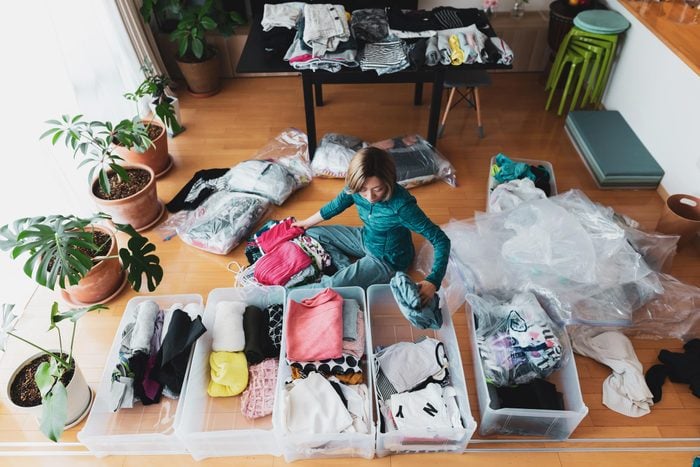How To Declutter a Room in 3 Easy Steps
Updated: Apr. 15, 2024

Clutter accumulates in no time and overwhelms our living spaces and minds. Get back on track with these three surefire steps.
Do you let your mail and magazines pile up? Has your kitchen junk drawer expanded to two or more drawers? That black hole of a closet could probably use some attention, too. Once something goes in, it never comes out.
Decluttering living spaces tops countless New Year’s resolution and spring-cleaning lists year after year. But how many of us actually do it? Why does the task seem so daunting? And what’s so bad about having a messy living space, anyway?
According to researchers at DePaul University, quite a bit. We see our homes as an outward reflection of our inner selves. When when it’s chaotic or cluttered, we internalize that chaos. Spaces that once brought us joy can become psychologically overwhelming. Learn how to start decluttering when it feels overwhelming.
But don’t worry. If your living spaces need attention, Michele Vig, founder and chief organizer at Neat Little Nest, will show you how to declutter your life and home in three easy steps.
Group by Category
So you’ve decided to declutter. Great! Now, where to begin?
When dealing with clutter, you may be tempted to start with a room. But, breaking things into small chunks helps make things manageable. But Vig says that’s not the best approach with decluttering.
“When you go room by room, it’s difficult to get a full picture of how much you have because you might have similar items scattered throughout the home,” says Vig. Instead, Vig says it’s better to declutter by category.
That category could be toys, books or anything else you have too much of. Some rooms lend themselves to a certain category, so start with the obvious. If you’re organizing your closet, that means clothes. But you may also have clothes in storage closets, boxes in the attic or the basement. That’s why it’s not a good idea to limit yourself to a single room.
If you’ve stashed clothes in multiple locations, Vig suggests gathering them from the other areas and evaluating them all at one time.
Make Decisions
Once you’ve decided what category to tackle first and gathered all those items together, it’s time to make decisions. But how do you know what to keep? What’s your criteria? Is it time to donate those skinny jeans? (Probably.)
Vig recommends two things when deciding what to keep and what to let go: Joy and service. As a certified organizing expert who studied with Marie Kondo, Vig says putting your items “through a filter of joy will help you focus your energy on keeping what you love.”
But, of course, not everything can fill your life with joy. Sometimes you need to unclog a sink drain. That’s where the “service” filter comes in.
Items like a mixing bowl and a plunger “might not bring you resounding joy, but do provide an important role of service in your home,” Vig says. “When you put items through those two filters, you will be left with things that provide you both great joy and important service and will be able to let the remaining items go.”
Organize
Filtering your items for joy and service leaves you with fewer things, but there’s one more step to be clutter-free: Organizing. What’s the sense in getting rid of things if you can’t find what you have left?
When organizing a space, it doesn’t matter if it’s a huge walk-in closet or a tiny bathroom drawer. Always put like with like, Vig says.
Start at the macro level. All clothes go in the closet. Then start subdividing. Long sleeves go together, tank tops go together. Vig says to keep going until you get to the micro level. “Put white tanks with white tanks and red tanks with red tanks,” she says.
After you’ve grouped like with like, get creative to keep things that way. “Use bins and storage items to help contain subcategories when it helps,” Vig says. Upcycle old mason jars into easy DIY storage for cotton swabs or tweezers, and make dividers out of wood to organize sock and underwear drawers.
“Some spaces, like a garage, might need a completely new storage system,” says Vig. “Other spaces, [like] a kids room, might need less design work. A few bins or baskets might solve the problem at hand.”
